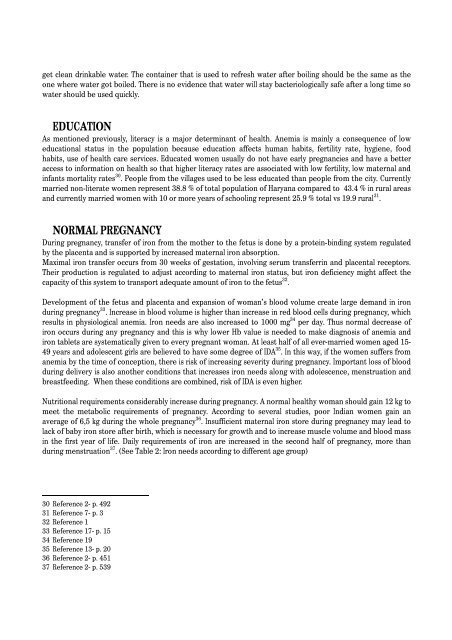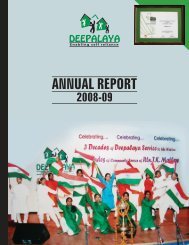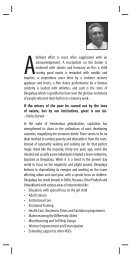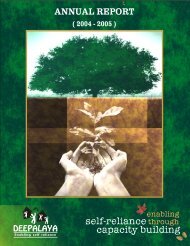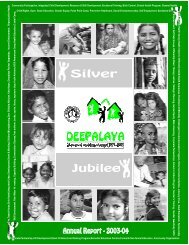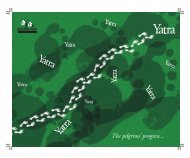Report 2011 - Deepalaya
Report 2011 - Deepalaya
Report 2011 - Deepalaya
You also want an ePaper? Increase the reach of your titles
YUMPU automatically turns print PDFs into web optimized ePapers that Google loves.
get clean drinkable water. The container that is used to refresh water after boiling should be the same as the<br />
one where water got boiled. There is no evidence that water will stay bacteriologically safe after a long time so<br />
water should be used quickly.<br />
EDUCATION<br />
As mentioned previously, literacy is a major determinant of health. Anemia is mainly a consequence of low<br />
educational status in the population because education affects human habits, fertility rate, hygiene, food<br />
habits, use of health care services. Educated women usually do not have early pregnancies and have a better<br />
access to information on health so that higher literacy rates are associated with low fertility, low maternal and<br />
infants mortality rates 30 . People from the villages used to be less educated than people from the city. Currently<br />
married non-literate women represent 38.8 % of total population of Haryana compared to 43.4 % in rural areas<br />
and currently married women with 10 or more years of schooling represent 25.9 % total vs 19.9 rural 31 .<br />
NORMAL PREGNANCY<br />
During pregnancy, transfer of iron from the mother to the fetus is done by a protein-binding system regulated<br />
by the placenta and is supported by increased maternal iron absorption.<br />
Maximal iron transfer occurs from 30 weeks of gestation, involving serum transferrin and placental receptors.<br />
Their production is regulated to adjust according to maternal iron status, but iron deficiency might affect the<br />
capacity of this system to transport adequate amount of iron to the fetus 32 .<br />
Development of the fetus and placenta and expansion of woman’s blood volume create large demand in iron<br />
during pregnancy 33 . Increase in blood volume is higher than increase in red blood cells during pregnancy, which<br />
results in physiological anemia. Iron needs are also increased to 1000 mg 34 per day. Thus normal decrease of<br />
iron occurs during any pregnancy and this is why lower Hb value is needed to make diagnosis of anemia and<br />
iron tablets are systematically given to every pregnant woman. At least half of all ever-married women aged 15-<br />
49 years and adolescent girls are believed to have some degree of IDA 35 . In this way, if the women suffers from<br />
anemia by the time of conception, there is risk of increasing severity during pregnancy. Important loss of blood<br />
during delivery is also another conditions that increases iron needs along with adolescence, menstruation and<br />
breastfeeding. When these conditions are combined, risk of IDA is even higher.<br />
Nutritional requirements considerably increase during pregnancy. A normal healthy woman should gain 12 kg to<br />
meet the metabolic requirements of pregnancy. According to several studies, poor Indian women gain an<br />
average of 6,5 kg during the whole pregnancy 36 . Insufficient maternal iron store during pregnancy may lead to<br />
lack of baby iron store after birth, which is necessary for growth and to increase muscle volume and blood mass<br />
in the first year of life. Daily requirements of iron are increased in the second half of pregnancy, more than<br />
during menstruation 37 . (See Table 2: Iron needs according to different age group)<br />
30 Reference 2- p. 492<br />
31 Reference 7- p. 3<br />
32 Reference 1<br />
33 Reference 17- p. 15<br />
34 Reference 19<br />
35 Reference 13- p. 20<br />
36 Reference 2- p. 451<br />
37 Reference 2- p. 539


